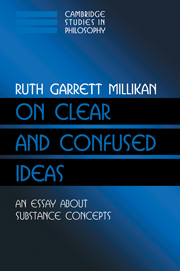Book contents
- Frontmatter
- Contents
- Preface
- Chapter 1 Introducing Substance Concepts
- Chapter 2 Substances: The Ontology
- Chapter 3 Classifying, Identifying, and the Function of Substance Concepts
- Chapter 4 The Nature of Abilities: How Is Extension Determined?
- Chapter 5 More Mama, More Milk and More Mouse: The Structure and Development of Substance Concepts
- Chapter 6 Substance Concepts Through Language: Knowing the Meanings of Words
- Chapter 7 How We Make Our Ideas Clear: Epistemology for Empirical Concepts
- Chapter 8 Content and Vehicle in Perception
- Chapter 9 Sames Versus Sameness in Conceptual Contents and Vehicles
- Chapter 10 Grasping Sameness
- Chapter 11 In Search of Strawsonian Modes of Presentation
- Chapter 12 Rejecting Identity Judgments and Fregean Modes
- Chapter 13 Knowing What I'm Thinking Of
- Chapter 14 How Extensions of New Substance Concepts are Fixed: How Substance Concepts Acquire Intentionality
- Chapter 15 Cognitive Luck: Substance Concepts in an Evolutionary Frame
- Appendix A Contrast with Evans on Information-Based Thoughts
- Appendix B What Has Natural Information to Do with Intentional Representation?
- References
- Index
Chapter 11 - In Search of Strawsonian Modes of Presentation
Published online by Cambridge University Press: 02 December 2009
- Frontmatter
- Contents
- Preface
- Chapter 1 Introducing Substance Concepts
- Chapter 2 Substances: The Ontology
- Chapter 3 Classifying, Identifying, and the Function of Substance Concepts
- Chapter 4 The Nature of Abilities: How Is Extension Determined?
- Chapter 5 More Mama, More Milk and More Mouse: The Structure and Development of Substance Concepts
- Chapter 6 Substance Concepts Through Language: Knowing the Meanings of Words
- Chapter 7 How We Make Our Ideas Clear: Epistemology for Empirical Concepts
- Chapter 8 Content and Vehicle in Perception
- Chapter 9 Sames Versus Sameness in Conceptual Contents and Vehicles
- Chapter 10 Grasping Sameness
- Chapter 11 In Search of Strawsonian Modes of Presentation
- Chapter 12 Rejecting Identity Judgments and Fregean Modes
- Chapter 13 Knowing What I'm Thinking Of
- Chapter 14 How Extensions of New Substance Concepts are Fixed: How Substance Concepts Acquire Intentionality
- Chapter 15 Cognitive Luck: Substance Concepts in an Evolutionary Frame
- Appendix A Contrast with Evans on Information-Based Thoughts
- Appendix B What Has Natural Information to Do with Intentional Representation?
- References
- Index
Summary
THE PLAN
There are many alternative ways that a mind or brain might represent that two of its representations were of the same object or property – the “Strawson” model, the “duplicates” model, the “equals sign” model, the “synchrony” model, the “Christmas lights” model, the “anaphor” model, and so forth (Section 10.1). In the last chapter I discussed what would constitute that a mind or brain was using one of these systems rather than another in order to mark identity. In this chapter, I discuss the devastating impact of the Strawson model of identity marking on the notion that there are such things as modes of presentation in thought. I will then argue that Evans' idea that there are “dynamic Fregean thoughts” has exactly the same implications as the Strawson model. In Chapter 12, I will claim that, in fact, all of the other models of identity marking we have discussed are strictly isomorphic to the Strawson model, hence have exactly the same devastating results for modes of presentation. There is no principled way to individuate modes of presentation such as to achieve any semblance of the set of effects for the sake of which Frege introduced them.
NAIVE STRAWSON-MODEL MODES OF PRESENTATION
Suppose that our minds/brains used Strawson markers for marking identity. Keeping clearly in mind that the project here is neither exegesis of Strawson's text nor exegesis of Frege's, let us ask what, on this model, would correspond most closely to the Frege-inspired notion that the same object can be thought of by a thinker under various different “modes of presentation.”
- Type
- Chapter
- Information
- On Clear and Confused IdeasAn Essay about Substance Concepts, pp. 147 - 158Publisher: Cambridge University PressPrint publication year: 2000



